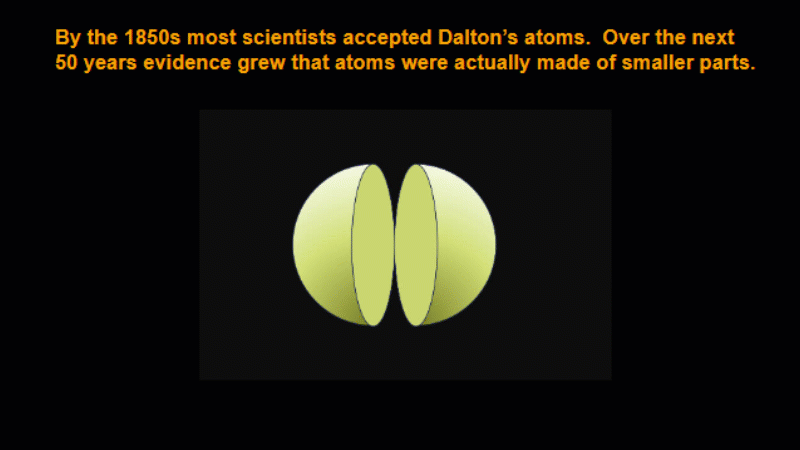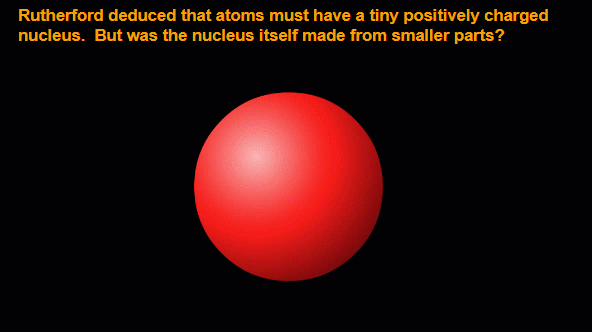Radioactivity Explained
2. Our changing picture of the atom
Good luck and dead ends
2.1 The plum pudding model
2.2 Rutherford and alpha scattering
2.3 Protons and neutrons
2.1 The plum pudding model
Short video summary (3:42)
-
Experiments suggested that atoms contained very small negatively charged particles
These came to be known as electrons
The first guess was that the negative electrons were embedded in an even sphere of equal positive charge
This was known as the plum pudding model
-
The story of the atom is one of dead ends, perseverance and lucky guesses.
By about 1850 scientists accepted that everything was made of atoms. And atoms were as small as it got.
The word atom literally means uncuttable in Greek - if you could cut one open you'd find it was the same all the way through.
Trying to understand electricity led scientists to question this assumption. They knew electricity could travel through the air as sparks. But did you need the air?
Around 1857 a German glassblower called Heinrich Geissler found that without much air a high voltage could cause a glow in a glass tube - no one knew why. Different gases made different colours - and so Geisller tubes became popular decorations.
An English scientist called William Crookes found that if you sucked out even more air, a high voltage just caused a glow at one end of a tube - again scientists disagreed about what caused it.
It seemed that there were strange rays coming from the metal terminal on the negative side or 'cathode'. These 'cathode rays' were blocked by thin metal and could even make a wheel turn. Light couldn't do this, so maybe they were particles of some kind?
Crookes also found that they could be deflected by a magnet, and the direction suggested they had a negative charge. Negatively charged particles should have been deflected by electrically charged plates.
The British scientist JJ Themson tried and continually failed to make them do this - which was a real problem for the particle theory. It caused on ongoing dispute between British and German scientists about whether these 'cathode rays' were particles or a kind of light.
In 1895 the French scientist Jean Perrin showed that if you deflected the beam onto two very thin thin sheets of gold leaf then they became negatively charged and repelled each other.
This led Thomson to try even harder to deflect the rays using charged plates, and eventually developed a pump that could remove almost all the air, and see the deflection that he'd predicted.
If all there is is atoms and empty space - then what were these particles? Were they some kind of charged atom? If the particles were smaller than even an atom then what were they?
By using an electric field to cancel out the effect of a magnetic field, Thomson managed to show that these charged particles probably were probably very, very tiny - so they couldn't be atoms themselves, but must be a part of atoms.
Thomson guessed an atom was like a 'plum pudding', with little 'plums' of negatively charged particles embedded in a 'pudding' of positive charge, so that overall the atom was neutral.
These negatively charged particles came to be known as electrons.
-
A common story is that JJ Thomson ‘discovered’ the electron in 1897, but this is like claiming Heinz suddenly ‘discovered’ the baked bean.
Obviously, there’s no need for students to know or remember the details of this bit of history, but it’s worthwhile getting across the idea that scientists built on other scientists’ ideas using their intuition and best guesses.
The idea of a plum pudding sounds faintly silly, but it was a perfectly reasonable guess, and had some mathematical justification. The electrons would repel each other, and so to keep them in the atom it made sense for them to be distributed somehow within a continuum of equal positive charge.
Key animations from the video for you to use in front of a class
Slideshow: History of the electron
2.2 Rutherford and alpha scattering
Short video summary (3:35)
-
The plum pudding model couldn’t account for why alpha particles very occasionally bounced back from very thin metal foils
Ernest Rutherford guessed that this must be because atoms had a very small, positively charged nucleus where almost all the mass of an atom was concentrated
-
No one was trying to disprove Dalton's picture of a structureless atom with their investigations into electricity.
But scientists try to make all their theories fit together - and the only way to fit together their theory of electricity and their theory of atoms was to break their current theory of atoms. This helped their understanding of both electricity and atoms.
In the same way, no one was trying to disprove the plum pudding model when they used it to explain the behaviour of radiation - but this is what happened.
In 1907 the larger-than-life New Zealand physicist Ernest Rutherford, who was originally one of JJ Thomson's students, was studying a recently discovered type of radiation made up of alpha particles.
Rutherford had deduced that alpha particles must be very fast moving and have a positive charge - we'll find out more in lesson 3.
He was professor of physics at Manchester University at the time, and he and his small team sometimes used film to detect the alpha particles.
If the alpha particles had to go through a very thin sheet of a mineral called mica, then this caused the outline to be blurred Rutherford asked his research student Hans Geiger (after whom the Geiger counter is named) to find out as much as he could. This would help them with their detection of alpha particles, and may tell them more about the plum pudding model.
The experiment was very boring to conduct because you had to sit in a darkened room for hours looking through a microscope to see tiny flashes of light. Geiger duly spent his time rotating the microscope a small distance and counting flashes as alpha particles were deflected by very, very thin metal foils.
Geiger noticed that sometimes the alpha particles were deflected by quite a big angle.
On the team was a young undergraduate called Ernest Marsden, only a couple of years out of school Rutherford suggested to Geiger that to give him practice he get Marsden to check if any actually bounced back. This was a really tedious task - and Rutherford assumed that the chances of detecting any were pretty much zero.
Amazingly, a few days later, Marsden reported that some alphas were indeed bouncing back. Rutherford was so amazed that he took over the experiment himself. He said it was like firing 15-inch artillery shells at a sheet of tissue paper - and every so often one just bounced back.
Rutherford worked on the problem for a whole year, and one day came into the lab very pleased, and announced that he knew what the atom looked like.
The spread out positive charge of the plum pudding model couldn't account for the bouncing back of the alpha particles, so it must be that almost the entire mass of the atom and all the positive charge must be concentrated in a tiny part at the middle of the atom.
Rutherford called this the nucleus of the atom. Very, very rarely an alpha particle happened to be going in exactly the right direction to hit the nucleus and, since positive charges repel, it bounced back off it.
So this is Rutherfords model - there is a tiny, very massive, positively charged nucleus surrounded somehow by JJ Thomson's electrons.
-
This is a wonderful story, because it shows the role of luck and creative thinking in science.
Rutherford and his team were working on alpha particles, not the structure of the atom. The deviation of alpha particles by thin foils was a purely secondary area of research to help them make better measurements of alpha particles.
But Rutherford had the freedom to pivot his research to where he thought the biggest opportunities were, which is why he ended up taking over an investigation that had previously been delegated to the most junior member of the team.
Key animations from the video for you to use in front of a class
Slideshow: Discovery of the nucleus
2.3 Protons and neutrons
Short video summary (3:10)
-
Further experiments with alpha radiation suggested that the nucleus of an atom was made from smaller particles that came to be called protons and neutrons
-
Rutherford's model of the atom is much closer to our modern picture than the plum pudding model, but the nucleus was still imagined as just a blob of positive charge.
Rutherford was principally interested in radiation and he thought that understanding more about the nucleus might help. An obvious question was: Is the nucleus itself made of smaller parts?
Another of Rutherford's collaborators called Frederick Soddy was doing experiments sending alpha particles through different gases. He found that particles just like the nucleus of hydrogen atoms were sometimes produced. Perhaps all nucleuses were made up of different numbers of hydrogen nucleuses?
Rutherford named the hydrogen nucleus a 'proton' which is the ancient Greek word for first.
The Dutch physicist Antonius van den Broek had suggested that an element was defined by the electric charge of its nucleus It's only a short step from this to defining an element by the number of protons that makes up its nucleus - which is what we learned about in lesson 1.
The problem was that protons couldn't account for the measured mass of a nucleus - the measured mass was always about twice as big as it should be. Soddy also realised that different nucleuses of the same element could have different masses - we came across this concept of isotopes in lesson 1 as well. Maybe the two observations were related?
It seemed likely that there were sort of neutral protons or 'neutrons' accounting for the rest of a nucleus's mass. The problem was that it would be very difficult to detect neutrons because they had no electric charge and so would tend to go straight through anything you could use to detect them.
In 1932, the French chemist Irene Joliot-Curie - the daughter of Marie Curie (of whom more later) - was working with her husband Frederick in Paris. They knew that when alpha particles were made to strike a thin sheet of beryllium there seemed to be some kind of ray that produced protons when it in turn hit paraffin wax, but they didn't know what the ray was.
Another of Rutherford's colleagues, James Chadwick, was convinced that these 'rays' were in fact a stream of neutrons. He imagined an alpha particle knocking out a neutron from a beryllium nucleus, which in turn knocked out a proton from the paraffin wax.
By repeating the experiment in lots of different ways and measuring how fast the protons moved, Chadwick could calculate the mass of a neutron - it turned out to be very slightly higher than the mass of a proton.
So that's it - we now have our modern view of an atomic nucleus - made from roughly equal numbers of positive protons and neutral neutrons.
-
Even though the syllabus doesn’t require students to know any details of these experiments, it’s a good example of how science predicts the existence of something completely new - the neutron - that is later discovered.
This is what makes science unique in human activity - it can point forwards in time, predicting new phenomena, not just explaining past observations.
Key animations from the video for you to use in front of a class
Slideshow: Protons and neutrons



